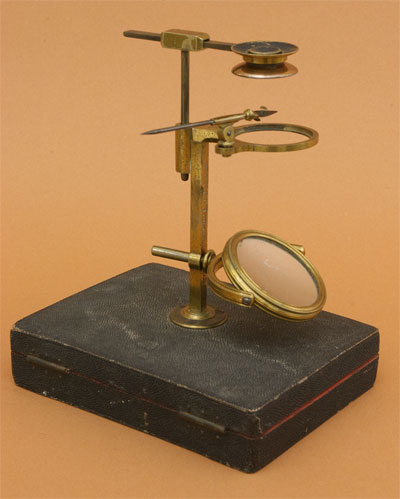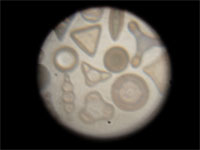 |
|||||
 |
 |
||||
 |
|||||
 |
 |
||||



This instrument is a simple microscope mounted on a rectangular pillar screwed into a boss mounted on a black fish skin covered box. The box acts as the support as well as the storage and carrying case. The pillar supports the mirror toward the base and the stage at the top. The stage dovetails into a suitable mount at the top. Pressed into a friction mount is a support rod with a rectangular friction mount at the top. The objective screws into a brass arm, which then presses into the friction mount. This assembly can then be focused by pushing the rod up or down, rotated in its friction mount, and translated within its own friction mount. These two axes of motion (up/down, left/right) constitutes what was known as the “Aquatic Movement”.
This microscope comes equipped with six objectives, four low magnification with Lieberkuhn reflectors, and two high magnification objectives without reflectors. Accessories include a stage forceps, two additional magnifying lenses, and two concave watch glasses. These glass accessories are probably not original.
Imaging is good for the mid 18th Century. An image of diatoms using objective “1” shows a magnification of approximately 100x, but showing considerable aberrations (chromatic, field curvature, etc). However, this instrument would have been perfectly adequate for the investigation of the morphology and anatomy of aquatic Corallines.
The microscope is engraved on the support pillar "J. CUFF Londini Fec.t"
Golub Collection microscope No. 13 is a very similar instrument made by Peter Dollond c1764. Dollond's aquatic microscope also contains a screwbarrel attachment.
This microscope was part of the Quinn Family collection.